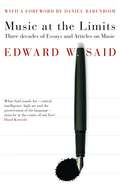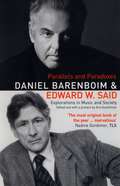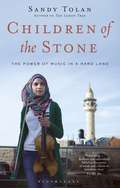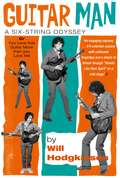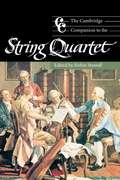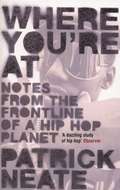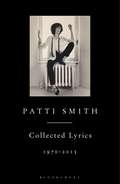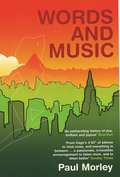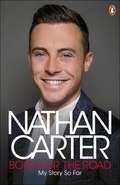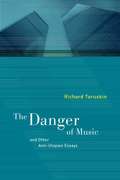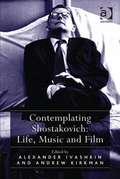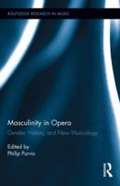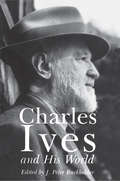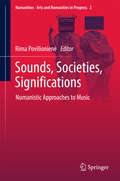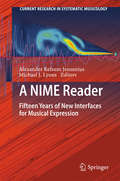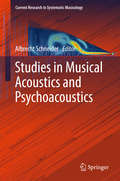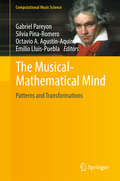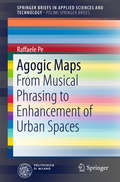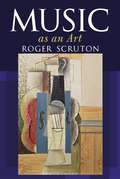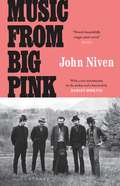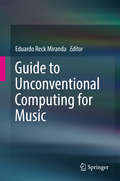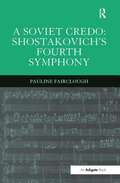- Table View
- List View
Bach and the Patterns of Invention
by Laurence DreyfusIn this major new interpretation of the music of J. S. Bach, we gain a striking picture of the composer as a unique critic of his age. By reading Bach's music "against the grain" of contemporaries such as Vivaldi and Telemann, Laurence Dreyfus explains how Bach's approach to musical invention in a variety of genres posed a fundamental challenge to Baroque aesthetics.
Music at the Limits: Three Decades Of Essays And Articles On Music
by Edward SaidMusic at the Limits brings together three decades of Edward W. Said's essays on music. Addressing the work of a wide variety of composers and performers, Said analyses music's social and political contexts, and provides rich and often surprising assessments. He reflects on the censorship of Wagner in Israel; the relationship between music and feminism; and the works of Beethoven, Bruckner, Rossini, Schumann, Stravinsky and others. Always eloquent and often surprising, Music at the Limits reinforces Said's reputation as one of the most influential writers of the twentieth century.
Parallels & Paradoxes: Explorations in Music and Society
by Daniel Barenboim Edward SaidIsraeli Daniel Barenboim, one of the finest musicians of our times, and Palestinian Edward Said, eminent literary critic and leading expert on the Middle East, have been close friends for years. Parallels and Paradoxes is a series of discussions between the two friends about music, politics, literature and society. Barenboim and Said talk about, among other subjects, the differences between writing prose and music; the compromising politician versus the uncompromising artist; Beethoven as the ultimate sonata composer, Wagner (Barenboim is considered by many to be the greatest living conductor of his work); great teachers; and the power of culture to transcend national differences. Illuminating and deeply moving, Parallels and Paradoxes is an affectionate and impassioned exchange of ideas.
Children of the Stone: The Power of Music in a Hard Land
by Sandy TolanChildren of the Stone is the unlikely story of Ramzi Hussein Aburedwan, a boy from a Palestinian refugee camp in Ramallah who confronts the occupying army, gets an education, masters an instrument, dreams of something much bigger than himself, and then inspires scores of others to work with him to make that dream a reality.That dream is of a music school in the midst of a refugee camp in Ramallah, a school that will transform the lives of thousands of children through music. Daniel Barenboim, the Israeli musician and music director of La Scala in Milan and the Berlin Opera, is among those who help Ramzi realize his dream. He has played with Ramzi frequently, at chamber music concerts in Al-Kamandjati, the school Ramzi worked so hard to build, and in the West-Eastern Divan Orchestra that Barenboim founded with the late Palestinian intellectual, Edward Said.Children of the Stone is a story about music, freedom and conflict; determination and vision. It's a vivid portrait of life amid checkpoints and military occupation, a growing movement of nonviolent resistance, the past and future of musical collaboration across the Israeli-Palestinian divide, and the potential of music to help children see new possibilities for their lives. Above all, Children of the Stone chronicles the journey of Ramzi Aburedwan, and how he worked against the odds to create something lasting and beautiful in a war-torn land.
Guitar Man: A Six-string Odyssey - Or, You Love That Guitar More Than You Love Me
by Will HodgkinsonWill Hodgkinson dreamt of being a guitar legend but never got round to it. Now in his thirties and married with children, he still nurtures hopes of emulating his heroes. So he decides to learn the guitar from scratch, start a band and play a gig before it's too late. On his journey of discovery, he picks up tips along the way from Johnny Marr and the Byrds' Roger McGuinn, and attempts to play Davey Graham's 'Anji'. Will his debut gig end in bum notes, 'musical differences' and disaster?
The Cambridge Companion to the String Quartet (Cambridge Companions to Music) (PDF)
by Robin StowellThe Cambridge Companion to the String Quartet (Cambridge Companions to Music)
Where You're At: Notes from the Frontline of a Hip Hop Planet
by Patrick NeatePinballing around the major cities of the world, from where it all began in the projects of Brooklyn and the Bronx to the excessive madness of Tokyo, from the random violence of Johannesburg, to the shanty towns of Rio, Whitbread Award-winning writer Patrick Neate explores the way how, through hip hop, the potent symbolism of black America has been acquired, used and subsumed by cultures on every continent to create a uniquely different form of globalism. A stunning musical journey and cultural odyssey, Where You're At is the story of how hip hop conquered the globe and nobody noticed.
Patti Smith Collected Lyrics, 1970–2015
by Ms Patti SmithAn American original, Patti Smith is a multi-disciplined artist and performer. Her work is rooted in poetry, which infused her 1975 landmark album, Horses. A declaration of existence, Horses was described as 'three chords merged with the power of the word'; it was graced with the now iconic portrait by Robert Mapplethorpe, the subject of her award-winning memoir Just Kids. Initially published in 1998, Patti Smith's Complete Lyrics was a testimony to her uncompromising poetic power. Now, on the fortieth anniversary of the release of Smith's groundbreaking album, Collected Lyrics has been revised and expanded with more than thirty-five additional songs, including her first, 'Work Song', written for Janis Joplin in 1970, and her most current, 'Writer's Song', to be recorded in 2015. The collection is liberally illustrated with original manuscripts of lyrics from Smith's extensive archive.Patti Smith's work continues to retain its relevance, whether controversial, political, romantic or spiritual. Collected Lyrics offers forty-five years of song, an enduring commemoration of Smith's unique contribution to the canon of rock and roll.
Words & Music: A History of Pop in the Shape of a City
by Paul MorleyHas pop burnt itself out? Inspired by the video for Kylie Minogue's hit single 'Can't Get You Out of My Head', acclaimed rock journalist Paul Morley is driving with Kylie towards a virtual city built of sound and ideas in search of the answer. Their journey bridges the various paradoxes of twentieth-century culture, as they encounter a succession of celebrities and geniuses - including Madonna, Kraftwerk, Wittgenstein and the ghost of Elvis Presley - and explore the iconic and the obscure, the mechanical and the digital, the avant-garde and the very nature of pop itself.
Born for the Road: My Story So Far
by Nathan CarterNathan Carter has become Ireland's biggest country music star. He is heralded by many as reviving the country music genre and bringing it into the mainstream. He has sold out venues across the UK and Ireland, has landed his own primetime show, and is loved and respected by legions of fans across Ireland.But how did a lad from Liverpool accomplish all this before the age of 27?In his revealing and inspirational autobiography, Nathan reminisces about his music filled childhood, and growing up in Merseyside with his Liverpool-Irish family. From his first taste of showbiz at the tender age of four, to his success on the north of England club circuit and his subsequent relocation to Donegal, Nathan explores the twists of fate that took him to chart success and to become Ireland's adopted poster boy for country music.
The Danger of Music: and Other Anti-Utopian Essays (PDF)
by Richard Taruskin"The Danger of Music" gathers some two decades of Richard Taruskin's writing on the arts and politics, ranging in approach from occasional pieces for major newspapers such as the "New York Times" to full-scale critical essays for leading intellectual journals. Hard-hitting, provocative, and incisive, these essays consider contemporary composition and performance, the role of critics and historians in the life of the arts, and the fraught terrain where ethics and aesthetics interact and at times conflict.Many of the works collected here have themselves excited wide debate, including the title essay, which considers the rights and obligations of artists in the aftermath of the 9/11 terrorist attacks. In a series of lively postscripts written especially for this volume, Taruskin, America's 'public' musicologist, addresses the debates he has stirred up by insisting that art is not a utopian escape and that artists inhabit the same world as the rest of society. Among the book's forty-two essays are two public addresses - one about the prospects for classical music at the end of the second millennium C. E., the other a revisiting of the performance issues previously discussed in the author's "Text and Act" (1995) - that appear in print for the first time.
Contemplating Shostakovich: Life, Music and Film
by Alexander Ivashkin Andrew KirkmanContemplating Shostakovich marks an important new stage in the understanding of Shostakovich and his working environment. Each chapter covers aspects of the composer's output in the context of his life and cultural milieu. The contributions uncover 'outside' stimuli behind Shostakovich's works, allowing the reader to perceive the motivations behind his artistic choices; at the same time, the nature of those choices offers insights into the workings of the larger world - cultural, social, political - that he inhabited. Thus his often ostensibly quirky choices are revealed as responses - by turns sentimental, moving, sardonic and angry - to the particular conditions, with all their absurdities and contradictions, that he had to negotiate. Here we see the composer emerging from the role of tortured loner of older narratives into that of the gregarious and engaged member of his society that, for better and worse, characterized the everyday reality of his life. This invaluable collection offers remarkable new insight, in both depth and range, into the nature of Shostakovich's working circumstances and of his response to them. The collection contains the seeds for a wide range of new directions in the study of Shostakovich's works and the larger contexts of their creation and reception.
Contemplating Shostakovich: Life, Music and Film (PDF)
by Alexander Ivashkin Andrew KirkmanContemplating Shostakovich marks an important new stage in the understanding of Shostakovich and his working environment. Each chapter covers aspects of the composer's output in the context of his life and cultural milieu. The contributions uncover 'outside' stimuli behind Shostakovich's works, allowing the reader to perceive the motivations behind his artistic choices; at the same time, the nature of those choices offers insights into the workings of the larger world - cultural, social, political - that he inhabited. Thus his often ostensibly quirky choices are revealed as responses - by turns sentimental, moving, sardonic and angry - to the particular conditions, with all their absurdities and contradictions, that he had to negotiate. Here we see the composer emerging from the role of tortured loner of older narratives into that of the gregarious and engaged member of his society that, for better and worse, characterized the everyday reality of his life. This invaluable collection offers remarkable new insight, in both depth and range, into the nature of Shostakovich's working circumstances and of his response to them. The collection contains the seeds for a wide range of new directions in the study of Shostakovich's works and the larger contexts of their creation and reception.
Masculinity in Opera: Gender, History, and New Musicology (Routledge Research In Music Ser. #6)
by Philip PurvisThis book addresses the ways in which masculinity is negotiated, constructed, represented, and problematized within operatic music and practice. Although the consideration of masculine ontology and epistemology has pervaded cultural and sociological studies since the late 1980s, and masculinity has been the focus of recent if sporadic musicological discussion, the relationship between masculinity and opera has so far escaped detailed critical scrutiny. Operating from a position of sympathy with feminist and queer approaches and the phallocentric tendencies they identify, this study offers a unique perspective on the cultural relativism of opera by focusing on the male operatic subject. Anchored by musical analysis or close readings of musical discourse, the contributions take an interdisciplinary approach by also engaging with theatre, popular music, and cultural musicology scholarship. The various musical, theoretical, and socio-political trajectories of the essays are historically dispersed from seventeenth to twentieth- first-century operatic works and practices, visiting masculinity and the operatic voice, the complication or refusal of essentialist notions of masculinity, and the operatic representation of the ‘crisis’ of masculinity. This volume will not only enliven the study of masculinity in opera, but be an appealing contribution to music scholars interested in gender, history, and new musicology.
Masculinity in Opera: Gender, History, and New Musicology (PDF) (Routledge Research In Music Ser. #6)
by Philip PurvisThis book addresses the ways in which masculinity is negotiated, constructed, represented, and problematized within operatic music and practice. Although the consideration of masculine ontology and epistemology has pervaded cultural and sociological studies since the late 1980s, and masculinity has been the focus of recent if sporadic musicological discussion, the relationship between masculinity and opera has so far escaped detailed critical scrutiny. Operating from a position of sympathy with feminist and queer approaches and the phallocentric tendencies they identify, this study offers a unique perspective on the cultural relativism of opera by focusing on the male operatic subject. Anchored by musical analysis or close readings of musical discourse, the contributions take an interdisciplinary approach by also engaging with theatre, popular music, and cultural musicology scholarship. The various musical, theoretical, and socio-political trajectories of the essays are historically dispersed from seventeenth to twentieth- first-century operatic works and practices, visiting masculinity and the operatic voice, the complication or refusal of essentialist notions of masculinity, and the operatic representation of the ‘crisis’ of masculinity. This volume will not only enliven the study of masculinity in opera, but be an appealing contribution to music scholars interested in gender, history, and new musicology.
Charles Ives and His World (The Bard Music Festival: 7) (PDF)
by J. BurkholderThis volume shows Charles Ives in the context of his world in a number of revealing ways. Five new essays examine Ives's relationships to European music and to American music, politics, business, and landscape. J. Peter Burkholder shows Ives as a composer well versed in four distinctive musical traditions who blended them in his mature music. Leon Botstein explores the paradox of how, in the works of Ives and Mahler, musical modernism emerges from profoundly antimodern sensibilities. David Michael Hertz reveals unsuspected parallels between one of Ives's most famous pieces, the Concord Piano Sonata, and the piano sonatas of Liszt and Scriabin. Michael Broyles sheds new light on Ives's political orientation and on his career in the insurance business, and Mark Tucker shows the importance for Ives of his vacations in the Adirondacks and the representation of that landscape in his music. The remainder of the book presents documents that illuminate Ives's personal life. A selection of some sixty letters to and from Ives and his family, edited and annotated by Tom C. Owens, is the first substantial collection of Ives correspondence to be published. Two sections of reviews and longer profiles published during his lifetime highlight the important stages in the reception of Ives's music, from his early works through the premieres of his most important compositions to his elevation as an almost mythic figure with a reputation among some critics as America's greatest composer.
Sounds, Societies, Significations: Numanistic Approaches to Music (Numanities - Arts and Humanities in Progress #2)
by Rima PovilionienėThis edited book covers many topics in musicological literature, gathering various approaches to music studies that encapsulate the vivid relation music has to society. It focusses on repertoires and geographical areas that have not previously been well frequented in musicology. As readers will see, music has many roles to play in society. Music can be a generator of social phenomena, or a result of them; it can enhance or activate social actions, or simply co-habit with them. Above all, music has a stable position within society, in that it actively participates in it. Music can either describe or prescribe social aspects; musicians may have a certain position/role in society (e.g., the “popstar” as fashion leader, spokesman for political issues, etc.). Depending on the type of society, music may have a certain “meaning” or “function” (music does not mean the same thing everywhere in the world). Lastly, music can define a society, and it is not uncommon for it to best define a particular historical moment. Case-studies in this work provide visibility for musical cultures that are rarely exposed in the dominant musicological discourse. Several contributions combine musicological analysis with "insider-musician" points of view. Some essays in the collection address the cultural clash between certain types of music/musicians and the respective institutional counterparts, while certain contributing authors draw on experimental research findings. Throughout this book we see how musics are socially significant, and - at the same time - that societies are musically significant too. Thus the book will appeal to musicologists, cultural scholars and semioticians, amongst others.
A NIME Reader: Fifteen Years of New Interfaces for Musical Expression (Current Research in Systematic Musicology #3)
by Alexander Refsum Jensenius Michael J. LyonsWhat is a musical instrument? What are the musical instruments of the future? This anthology presents thirty papers selected from the fifteen year long history of the International Conference on New Interfaces for Musical Expression (NIME). NIME is a leading music technology conference, and an important venue for researchers and artists to present and discuss their explorations of musical instruments and technologies. Each of the papers is followed by commentaries written by the original authors and by leading experts. The volume covers important developments in the field, including the earliest reports of instruments like the reacTable, Overtone Violin, Pebblebox, and Plank. There are also numerous papers presenting new development platforms and technologies, as well as critical reflections, theoretical analyses and artistic experiences. The anthology is intended for newcomers who want to get an overview of recent advances in music technology. The historical traces, meta-discussions and reflections will also be of interest for longtime NIME participants. The book thus serves both as a survey of influential past work and as a starting point for new and exciting future developments.
Studies in Musical Acoustics and Psychoacoustics (Current Research in Systematic Musicology #4)
by Albrecht SchneiderThis book comprises twelve articles which cover a range of topics from musical instrument acoustics to issues in psychoacoustics and sound perception as well as neuromusicology. In addition to experimental methods and data acquisition, modeling (such as FEM or wave field synthesis) and numerical simulation plays a central role in studies addressing sound production in musical instruments as well as interaction of radiated sound with the environment. Some of the studies have a focus on psychoacoustic aspects in regard to virtual pitch and timbre as well as apparent source width (for techniques such as stereo or ambisonics) in music production. Since musical acoustics imply subjects playing instruments or singing in order to produce sound according to musical structures, this area is also covered including a study that presents an artificial intelligent agent capable to interact with a real ('analog') player in musical genres such as traditional and free jazz.
The Musical-Mathematical Mind: Patterns and Transformations (Computational Music Science)
by Gabriel Pareyon Silvia Pina-Romero Octavio A. Agustín-Aquino Emilio Lluis-PueblaThis book presents a deep spectrum of musical, mathematical, physical, and philosophical perspectives that have emerged in this field at the intersection of music and mathematics. In particular the contributed chapters introduce advanced techniques and concepts from modern mathematics and physics, deriving from successes in domains such as Topos theory and physical string theory. The authors include many of the leading researchers in this domain, and the book will be of value to researchers working in computational music, particularly in the areas of counterpoint, gesture, and Topos theory.
Agogic Maps: From Musical Phrasing to Enhancement of Urban Spaces (SpringerBriefs in Applied Sciences and Technology)
by Raffaele PeThis book explores the value of the musical concept of “agogics” – the modification of regular rhythm to enhance expressive potential – in understanding urban spatial configurations within the current technological context and in developing urban maps that exploit sonic signals to create an open learning framework. The book starts by discussing the meaning and significance of agogics in the musical and artistic realm, with reference to the work of Adolphe Appia, Emile-Jaques Dalcroze, and Iannis Xenakis, among others. Its relevance to cartography and mapping is then examined, taking into account the contributions of Ian McHarg, Bill Hillier, Mark Shepard, and Robin Minard. The nature and value of agogic maps, for example in fostering awareness of place and effective organization of spatial development, are described in detail, with reference to case studies in Dar es Salaam, Tanzania and Segrate, Italy. It is explained how agogic maps take advantage of innovative categories and scripting equipment to provide a new mapping instrument for spatial and urban configurations, highlighting the interdependence between aural signals and spatial variables. This book will be of interest to architects, urbanists, and musicians with a specific interest in space and sound design.
Music as an Art
by Sir Roger ScrutonMusic as an Art begins by examining music through a philosophical lens, engaging in discussions about tonality, music and the moral life, music and cognitive science and German idealism, as well as recalling the author's struggle to encourage his students to distinguish the qualities of good music. Scruton then explains – via erudite chapters on Schubert, Britten, Rameau, opera and film – how we can develop greater judgement in music, recognising both good taste and bad, establishing musical values, as well as musical pleasures.As Scruton argues in this book, in earlier times, our musical culture had secure foundations in the church, the concert hall and the home; in the ceremonies and celebrations of ordinary life, religion and manners. Yet we no longer live in that world. Fewer people now play instruments and music is, for many, a form of largely solitary enjoyment. As he shows in Music as an Art, we live at a critical time for classical music, and this book is an important contribution to the debate, of which we stand in need, concerning the place of music in Western civilization.
Music From Big Pink (33 1/3 Ser.)
by John Niven Barney Hoskyns'I love John Niven's writing – OBVIOUSLY – but came late to his first book, and was blown away by what vivid, delicate time-travel it is. Every The Band fan in the world MUST read it - it's like living in the music. Just smoky, ravishing magic' Caitlin MoranTimed to coincide with the fiftieth anniversary of the release of The Band's debut album, Music from Big Pink is John Niven's first novel – a heady blend of drugs, music, sixties counter-culture and intoxicating youth.Greg Keltner is a 23-year-old drug-dealer and wannabe musician. Through his eyes, we witness the gestation of a record that will go on to cast its spell across five decades – bewitching and inspiring artists as disparate as The Beatles, Eric Clapton, Wilco and Mercury Rev. Music From Big Pink is faction: real people like Richard Manuel, Rick Danko, Bob Dylan and Albert Grossman rub shoulders with fictional characters and imagined scenarios. Featuring a new foreword from Barney Hoskyns and a new introduction from the author, Music from Big Pink gives us a unique and vivid insight into the birth and legacy of The Band's debut album.
Guide to Unconventional Computing for Music
by Eduardo Reck MirandaThis pioneering text/reference explores how innovative new modes of computation may provide exciting new directions for future developments in the music industry, guiding the reader through the latest research in this emerging, interdisciplinary field. This work includes coverage of electronic music compositions and performances that incorporate unconventional interfacing, hacking and circuit bending. Features: presents an introduction to unconventional computing in music; discusses initiatives involving biophysical electronic music, the work of self-styled silicon luthiers, and the intersection of music and quantum computing; introduces the memristor, a new electronic component with the potential to revolutionize how computers are built; reviews experiments and practical applications of biological memristors in music; describes IMUSIC, an unconventional tone-based programming language, which enables the programming of computers using musical phrases; includes review questions at the end of each chapter.
A Soviet Credo: Shostakovich's Fourth Symphony (PDF)
by Pauline FaircloughComposed in 1935-36 and intended to be his artistic 'credo', Shostakovich's Fourth Symphony was not performed publicly until 1961. Here, Dr Pauline Fairclough tackles head-on one of the most significant and least understood of Shostakovich's major works. She argues that the Fourth Symphony was radically different from its Soviet contemporaries in terms of its structure, dramaturgy, tone and even language, and therefore challenged the norms of Soviet symphonism at a crucial stage of its development. With the backing of prominent musicologists such as Ivan Sollertinsky, the composer could realistically have expected the premiere to have taken place, and may even have intended the symphony to be a model for a new kind of 'democratic' Soviet symphonism. Fairclough meticulously examines the score to inform a discussion of tonal and thematic processes, allusion, paraphrase and reference to musical types, or intonations. Such analysis is set deeply in the context of Soviet musical culture during the period 1932-36, involving Shostakovich's contemporaries Shebalin, Myaskovsky, Kabalevsky and Popov. A new method of analysis is also advanced here, where a range of Soviet and Western analytical methods are informed by the theoretical work of Shostakovich's contemporaries Viktor Shklovsky, Boris Tomashevsky, Mikhail Bakhtin and Ivan Sollertinsky, together with Theodor Adorno's late study of Mahler. In this way, the book will significantly increase an understanding of the symphony and its context.

